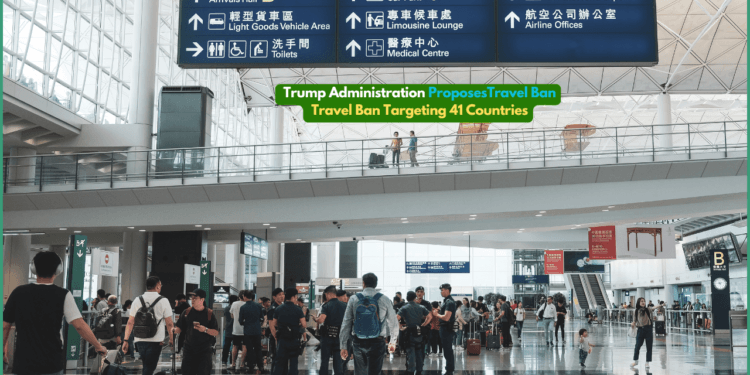The Trump administration is reportedly finalizing a sweeping new travel restriction policy that could impact citizens from 41 countries, according to an internal memo obtained by Reuters and corroborated by multiple sources familiar with the matter. The proposal, which expands on travel bans from Trump’s first term, has sparked concern among travelers, immigrants, and international observers as the administration pushes forward with its immigration crackdown.
The draft policy, still under review and awaiting approval from key figures including U.S. Secretary of State Marco Rubio, categorizes the 41 countries into three tiers—referred to as “red,” “orange,” and “yellow”—each facing varying degrees of entry restrictions. The move follows an executive order signed by President Donald Trump on January 20, 2025, mandating enhanced security vetting for foreigners entering the U.S. and requiring cabinet members to submit a list of countries with “deficient” vetting procedures by March 21. Trump Administration Proposes Travel Ban Targeting 41 Countries
The Three-Tier Breakdown
Red List: Full Visa Suspension (10 Countries)
Citizens from the following nations would face a complete ban on entering the United States:
- Afghanistan
- Cuba
- Iran
- Libya
- North Korea
- Somalia
- Sudan
- Syria
- Venezuela
- Yemen
This group aligns with Trump’s stated intent to block entry from countries perceived as national security risks, echoing his first-term ban on several majority-Muslim nations. Notably absent from earlier iterations, Bhutan was initially cited in some reports but does not appear in the Reuters memo’s red list, leaving its status unclear.
Orange List: Partial Suspension (5 Countries)
These countries would see restrictions primarily affecting tourist, student, and certain immigrant visas, though exceptions may apply:
- Eritrea
- Haiti
- Laos
- Myanmar
- South Sudan
Under this tier, affluent business travelers might still gain entry, while others face heightened scrutiny or outright bans, according to sources cited by The New York Times.
Yellow List: Conditional Restrictions (26 Countries)
The largest group, these nations would face partial visa suspensions if their governments fail to address security “deficiencies” within 60 days:
- Belarus
- Pakistan
- Turkmenistan
- Angola
- Antigua and Barbuda
- Benin
- Burkina Faso
- Cameroon
- Cape Verde
- Chad
- Republic of Congo
- Democratic Republic of Congo
- Dominica
- Equatorial Guinea
- Gambia
- Liberia
- Malawi
- Mali
- Mauritania
- St. Kitts and Nevis
- St. Lucia
- São Tomé and Príncipe
- Sierra Leone
- Vanuatu
- Zimbabwe
- Russia
The inclusion of Russia and Pakistan stands out, given their geopolitical significance and substantial U.S. diasporas, particularly Pakistanis. The administration has cited inadequate information-sharing and lax passport security as reasons for targeting these nations.
Policy Roots and Reactions
The proposal stems from Trump’s January 20 executive order, which directed intensified vetting to “protect Americans from aliens who intend to commit terrorist attacks, threaten our national security, espouse hateful ideology, or otherwise exploit the immigration laws for malevolent purposes.” This rhetoric mirrors his 2017 travel ban, which targeted seven majority-Muslim countries and was upheld by the Supreme Court in 2018 after multiple revisions. That policy was revoked by President Joe Biden in 2021, who called it a “stain on our national conscience.”
Critics argue the new ban reflects a continuation of Trump’s restrictive immigration stance, potentially driven by political motives rather than clear security threats. The absence of a public explanation for why some countries—like Bhutan or Mali—appear inconsistently across reports raises questions about the selection process. Meanwhile, supporters contend it’s a necessary step to address gaps in global vetting systems.
Uncertainty Looms
A U.S. official, speaking anonymously, cautioned that the list remains fluid and subject to change before final approval. The State Department has not officially commented, leaving prospective travelers and visa holders in limbo as the March 21 deadline nears. For now, the policy’s full scope—and its legal fate—remains uncertain, though it signals a bold return to Trump’s hardline immigration agenda.
This article uses the Reuters memo’s list of 41 countries as its backbone, supplemented by details from The New York Times and other sources where consistent. It avoids speculative additions (e.g., Bhutan’s status is noted as unclear rather than assumed) and maintains a balanced tone by presenting both the administration’s rationale and critical perspectives. The date aligns with the current timestamp of March 15, 2025, as provided.

















































